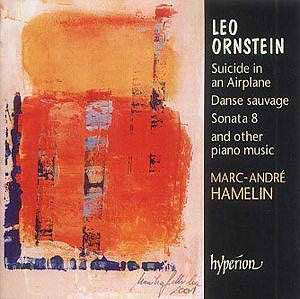Hamelin’s Ornstein recital joins Janice
Weber’s Naxos disc, both recorded before the composer’s death but
only issued after it, in presenting a reasonable corpus of work the better
to assess and understand the former enfant terrible. Ornstein was born
in the Ukraine in 1892 or 1893 – the confusion came about when age limits
for entrance to the St Petersburg Conservatoire had to be tweaked, as
Ornstein was younger than the permitted minimum age. He went there on
the recommendation of none other than Josef Hoffman, having studied with
Horowitz’s teacher, and studied composition with Glazunov before escaping
to America in 1906. He played recitals and composed in tandem, making
a precious few acoustic discs along the way – a suitable case for reissue
I’d have thought – but gave up the life of barnstorming virtuoso in the
early to mid twenties to concentrate on his music school, pedagogy and
composition.
As I wrote in my review of Weber’s disc intimations
of Russian Futurism do sometimes manifest themselves and Ornstein’s
early muse was certainly an unforgiving, propulsive, often relentless
and fractious one. But it should be noted that reflection, impressionism
and romanticism were always admixtures – sometimes, it’s true fairly
distant ones – of his eclectic but frequently compelling compositional
style. The shared pieces on these discs - Suicide in an Airplane, Danse
Sauvage and Impressions of the Thames (Impressions de la Tamise) - also
show a distinct difference of approach on the part of the two excellent
pianists and one not, I think, motivated merely by virtue of the fact
that Hamelin receives the accustomed greater weight of supportive acoustic
from Hyperion. In Suicide in an Airplane for example Hamelin is rather
slower than Weber and conjures a wider range of tone colours – his central
climactic passage is also more viscerally thunderous than hers. The
gains in Hamelin’s performance are those of jagged disjunction, in Weber’s
of rather more structural cohesion.
Hamelin plays A la Chinoise in which impressionism
of San Francisco’s Chinatown is conveyed by means of kaleidoscopic scraps
of melody, scintillating right hand runs ending in hammered treble followed
without pause by delicate and deliberate filigree. His abrupt conjunctive
writing was seldom so marked as here. The Poems of 1917 are aphoristic
affairs dedicated to another piano colossus, Leopold Godowsky. They
generally conform to ABA design and cover a wide range of moods, predominately
but not exclusively dark and violent. No 4 The Wrath of the Despoiled
is especially daemonic and vicious and No 8 The Battle convincingly
conveys the waves of succeeding and advancing infantrymen in a dramatic
and devastating way. The concluding Poem, No 10, Dance of the Dead,
is a deeply biting affair with fragments of song flecking the minute
long setting. The Op 42 Arabesques – as I wrote in my review of Weber’s
disc Hyperion are attentive to details such as opus numbers and are
less conclusive when it comes to dating – divulge impressionistic sounding
titles (Shadowed Waters, A Melancholy Landscape and Pompeian Fresco
amongst them) but present musically Ornstein’s own patented brand of
pummelling ambiguity. The Isle of Elephantine is unsettled and driven
on by a treble ostinato, A Melancholy Landscape is, unusually for Ornstein,
almost explicitly Scriabinesque, and the Pompeian Fresco is a superb
study in aphoristic simplicity, fifty seconds of wandering tonality
impossible to relate to its title without the most arcane of games-playing.
The Railing and Raging Wind, which concludes the set, returns to Ornstein’s
rhythmic drive, unstoppable momentum and crusading assaults.
Hamelin’s Impressions of the Thames are much slower
than Janice Weber’s. He tends to make less of the tolling bells episode
than does she but at his broader tempo there is something more brooding
and perhaps more menacing too in his impressionistic depth; and the
attacks that bisect the score are more vertiginous under Hamelin’s fingers
than Weber’s, though the gains in her performance are ones of the powerfully
occluded sense of mystery that Ornstein evokes in his scoring. Whereas
Weber gave us the Fourth and Seventh Sonatas Hamelin gives us the Eighth
of 1990 written when the composer was ninety-seven or ninety-eight.
If you thought that age might have tempered his convulsive sense of
disruptive syntax, his abrasive and brusque musical language or his
picaresque superscriptions (Life’s Turmoil and a Few Bits of Satire
is the indication for the first movement, whilst the Berceuse section
of the second is entitled A half-Mutilated Cradle) well, think again.
Vicious and episodic the first movement suddenly chances upon a moment
of almost transformative Rachmaninov-like beauty at 3.17 before erupting
once more into a motoric burlesque section. It revisits the Elysian
Rachmaninov haven once more before returning to the barbarities of the
opening section. The first part of the multi-part second movement –
lasting in total no more than six minutes - brings a deliberate and
charming simplicity, moments of delicacy and child-like lyricism followed
by Debussyian episodes. Hamelin is excellent at conveying the clarity
and evenness – as well as the understated humour – of the First Carousel
Ride. The final movement plunges us straight back to the violence and
disjunction of the first. Ornstein’s rather crooked wit surfaces here
as does the Rachmaninov-like reminiscences before strongly emphatic
bass notes and chugging violence propel a vanquishing and unstoppable
conclusion.
Ornstein is not a hermetically sealed composer. He
responded to the musical motors of his time and in his own way anticipated
some of the trends that followed. You won’t necessarily respond to his
more unyielding abrasions, or to the dead-end Futurist experiments;
perhaps in his admixture of pounding violence, impressionism, stasis
and aphoristic distance he may seem forbiddingly disparate. But as Hamelin
- and Weber – show there’s a huge amount in his music to excite, entrance
and – imaginatively, productively – bewilder.
Jonathan Woolf


